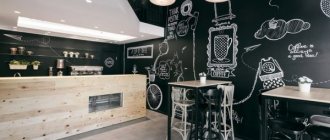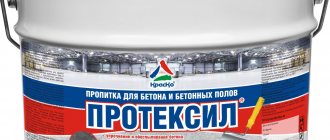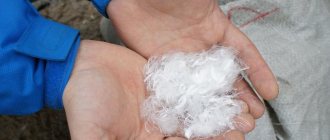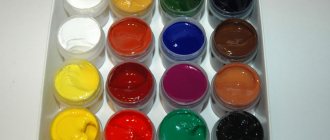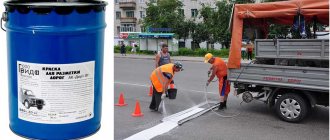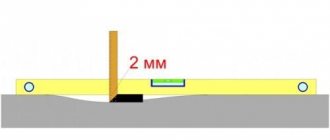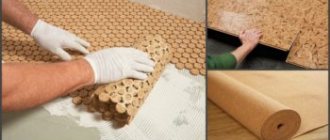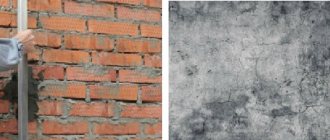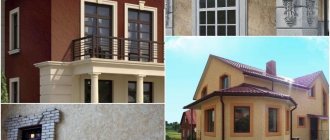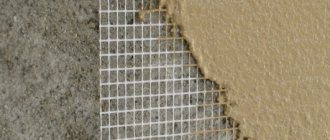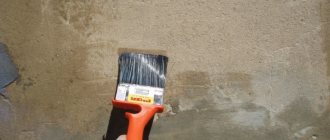Silicate paints are a special category of paint and varnish coatings used for the design of facades and interior work. Surfaces painted with their help tolerate changes in temperature and air humidity well, and resist the effects of ultraviolet radiation. The quality of wall finishing and their reliable protection from external environmental factors depend on the correct choice of material.
House facade painted with silicate paint.
Composition of silicate CM
Paintwork materials of silicate composition are applied to a base of brick and concrete. The coating repels dust, so it is used for painting facades. KM is applied as road markings.
Liquid potassium glass is the main element in the composition of silicate CM. Additional fillers are also introduced:
- minerals as pigments;
- silicon;
- ethyl silicate;
- fine particles of zinc and aluminum.
Dyes are endowed with anti-corrosion properties if they contain powdered metals. The silicate coating is characterized as durable. This quality is endowed by the main element (potassium glass). Anti-alkaline mineral pigments are additional paint components. Used: burgundy, azure, crown of lead, chromium oxide and umber.
Silicate facade paints are purchased in packaging that contains a paper bag of a dry base with pigments and a container with a solution of potassium glass. To start working with CM, these two parts of the package are mixed. Liquid glass has a density of 1.41 g/cm3. The covering layer of paint allows the facade to “breathe”.
The silicate layer does not fit well on the facade if it was previously covered with acrylic or alkyd. The base must be thoroughly cleaned of the old coating.
Application technology
There are no special requirements for the application of silicate paints for both interior and exterior work. The usual list of activities performed during any painting work is suitable here. Except for the primer. We have already said that you can not use it at all, or use only silicate primer. To do this, mix liquid glass with water in a ratio of 1:3.
- The surface for painting must be prepared. First, it is removed from the old finish and leveled. If the unevenness is deep and extensive, then plastering work is performed. If the defects are minor, they can be filled with liquid glass, dried and polished.
- If you decide to work with a primer, then it must be applied in an even layer using a roller with a velor cover. Drying will take 11-12 hours at an air temperature of about 25°C.
- When a ready-made composition of the desired color is used, it is stirred thoroughly. If necessary, the paint can be diluted with clean water. To apply to a solid surface, it is convenient to use a roller; it is better to get into hard-to-reach places with a brush. You can also use a spray bottle, but do not forget to use personal protective equipment.
- When using two-component mixtures, you first need to prepare a composition with a creamy consistency, add the desired pigment to it and mix thoroughly. In order to save money, you should not prepare a large amount of coloring composition at once.
The consumption of silicate paint per 1 m2 of painted area in one layer is approximately 140-150 grams. But this value may vary depending on the condition of the surface and its ability to absorb liquids.
- Exterior finishing
Main indicators of KM
Classification of silicate dye by silicate:
- a group of dyes based on dry pigment – zinc white;
- a group of materials where the pigment is calcium borate.
Technical characteristics declared by manufacturers:
- dispersion density – 1.3-1.7 kg/dm3;
- according to the DIN EN 13300 standard, covering power is second class;
- moisture resistance regulated by DIN EN 13300 standard - first class (the indicator depends on the brand);
- water absorption kg/(m2h 0.5) at a coefficient of 0.1. The lower the indicator, the more the coating tolerates moisture;
- grinding index – 60 µm;
- pH in the range of 8.5-11.5;
- For a single-layer coating, from 100 to 250 ml/m2 is consumed;
- recommended temperature at the time of paint application is 5-30°C above zero;
- The action time of the hardener (silicatization) is about 8 hours.
A day after the CM was applied, the first layer of coating dries. The second layer – after 10 hours.
Flaws
Silicate paint has a lot of positive qualities. However, it is not without its drawbacks. They should be considered before applying such a composition. Paints in this group belong to the category of toxic substances. They are unsafe for humans and the environment if used incorrectly.
When working with paint, it is necessary to provide high-quality protection for the skin, eyes, and respiratory tract from this composition entering the body. This product is also incompatible with plastic materials and natural wood. Therefore, the range of its application is limited. Once applied, the paint cannot be washed off by any means. The surface is cleaned exclusively mechanically.
Having considered the features that silicate paint has, we can note a lot of its advantages. Such a product, even with some of its shortcomings, is popular among Russian buyers.
Features of using CM
Silicate paint for the facade is applied to brick and concrete bases. This is its peculiarity. Not all dyes are applied to such surfaces. Acrylic does not cover brick and concrete because it does not have special density or plasticity.
It is recommended to apply silicone coating to mineral surfaces or mineral paint substrates. It is liquid glass, as the main constituent element, that influences the formation of many technical features of the composition:
- the coating is reliable and durable;
- material with a high degree of tenacity with any base;
- walls covered with paint “breathe”;
- vapor-permeable coating;
- resistance to water is noted;
- long service life;
- UV filters neutralize the effects of ultraviolet rays.
Silicate paint has much in common with silicone composition for facades: they cover any base, often painting concrete and brick. They do not require additional antiseptics. If you compare them in price with acrylic, then both materials are more expensive.
Compatibility with other dyes
When restoring a building or carrying out planned repairs, it is not always possible to remove the old coating. In addition to enamels, primers and putties may be present on the walls. In order for the coloring to be completed successfully, you need to select materials that suit each other. The table of compatibility of silicate paint with other dyes will help with this.
| Old paintwork | Silicate paint |
| Water-dispersed | — |
| Oily | — |
| Enamels HB | — |
| Organosilicon (KO) | — |
| Silicate | + |
| Acrylic | — |
| Water-dispersed | — |
| Alkyd (PF) | — |
| Chlorinated polyethylene (CP) | — |
As can be seen from the table, silicate compounds can be applied to surfaces coated with similar substances. They react chemically with other dyes. This will have a bad effect on the quality of the finishing coating.
Positive and negative aspects of using CM
For paint that is applied to the facade, moisture resistance is an important positive quality. The coating is washable and retains its color brightness. In addition, a thin glass film protects the wall from fungus and mold. The protective layer lasts for at least 20 years.
The dye transfers:
- adverse atmospheric phenomena;
- exposure to direct sunlight;
- exposure to fire (fire resistance);
- mechanical damage;
- action of chemical acids.
But there are also disadvantages to working with silicate dye:
- the material is not applied to surfaces with small cracks without preparing the base;
- poor ductility;
- poor interaction with a surface previously painted with another type of paint;
- metal, stone, ceramics are not painted;
- not used for painting inside living rooms;
- If there is a need to change the façade composition, it will be difficult to do so. more often the silicate is removed along with the putty layer.
Self-calculation
As a rule, manufacturers post a calculator on their websites that allows you to calculate how much paint you need to buy. But you can do the calculation yourself.
If the manufacturer indicates paint consumption on the packaging, then the exact consumption per 1 m² is very easy to calculate. For example, if a consumption of 10 m² / l is indicated, this means that 100 ml of paint will be required to paint 1 m² of wall.
How much paint do you need?
To calculate how many liters (or kilograms) of material you need to purchase to paint the entire house, you need to decide on the number of layers that will be applied. As a rule, the surface of the walls is covered with two layers of paint. It happens much less often that only one layer is applied. Sometimes painting is carried out using more layers. If the walls are coated with a primer, the manufacturer may suggest that the consumer limit himself to one layer. When calculating for porous or rough surfaces, approximately another 20% is added to the consumption indicated by the manufacturer on the packaging. Complex moldings and fittings will require additional painting.
Therefore, to calculate the amount of paint that needs to be purchased, you need to multiply A (paint consumption per 1 m² of wall) by B (wall area), and then by C - the number of layers.
Then, in order to avoid unpleasant surprises during work, the obtained result should be increased by another 10% -20%.
How to calculate the cost of painting a square meter of a house
To calculate the surface area of all the walls, you need to measure the length of each wall, add all the lengths together and multiply by the height of the house. But, of course, not everyone has a house that looks like a box of matches. In the figure we see that the red square has the same area as the blue triangle. This means that the surface area of a triangular wall is not so difficult to calculate. Of course, you need to remember to measure doors, windows, and other areas that are not being painted to subtract the resulting area from the square footage of the job (this is about 10% of the total surface area of the walls).
Room dimensions for measuring wall area
Formulas for calculation
Classification by type
Today, 2 types of dye are used:
- based on liquid glass;
- made from ethyl silicate.
There are 2 subtypes of silicate coatings:
- the share of acrylic in the dispersion silicate material is 10%. It acts as a binding element, which reduces the diffusion properties of the dye. There is no thorough preparation of the base before painting.
- The silicone resin in the composition of the CM allows the silicate-silicone coating to allow air to pass through, and the wall “breathes”. In addition, the protective layer is vapor-permeable and water-repellent. The facade is maximally protected from various precipitations.
Marking
Bricks of the modification in question available on the building materials markets have mandatory markings. The following three notations are primarily used:
- Durability brand. Denoted by the letter "M". For example, M125 - the higher the digital value, the more durable and reliable the structure will be.
- Frost resistance category. Displayed as "F". For example, F100 means that the material will withstand 100 cycles of freezing and defrosting.
- Thermal conductivity. The higher this indicator, the worse the material retains heat. Therefore, a thicker wall or the use of insulation is required.
Offers from manufacturers
Using paint from a well-known brand is the key to a high-quality protective layer for the facade.
- Austria, Baumit Silikat Color Repro – silicate dye is expensive and requires a lot of consumption, but is quite in demand on the construction market;
- Germany, Pufas Fassaden-Silikat – coating of pastel shades, with an affordable price, is used for interior work (basements of old buildings are painted) and exterior;
- Poland, Ceresit CT 54 – the composition is waterproof, but with high consumption. Not applied only to gypsum surfaces;
- Finland, Tikkurila Finngard Silikaat Timaali - dirt-repellent, frost-resistant material. High consumption is its disadvantage;
- Germany, Caparol Sylitol-Minera – the coating will be effective if 2 layers are applied. The dye is used sparingly. The material is on sale at a high price.
Briefly about the main thing
Sand-lime brick is no different in shape and size from its standard ceramic counterpart. However, in terms of composition and production technology, this is a completely different building material. It consists of 90% quartz sand and 10% lime, water, plasticizers and dyes. Among its main advantages are:
- Great strength.
- Frost resistance.
- Low cost.
- Safety.
- Accuracy of shapes and sizes.
- Heat resistance.
- Soundproofing.
- Aesthetics.
The main disadvantages include heavy weight, insufficient thermal insulation, high moisture saturation coefficient and susceptibility to destruction in a humid environment. By structure, bricks are divided into solid and hollow, by purpose - into ordinary and facing, by color - into regular and colored, by size - into single, one-and-a-half and double. The marking indicates the strength grade, frost resistance and thermal conductivity. Bricks are used both for capital construction and for external finishing and creating partitions.
Ratings 0
Preparatory work before painting
It will not be possible to obtain a high-quality protective layer without taking into account the specifics of its application to the facade.
- The wall is examined for the presence of old paint coating.
- Plaster that has lost its integrity is removed from the surface. If you do not inspect the façade before painting, the new protective layer will peel off.
- The base is pre-primed so that there is no excess moisture on its surface.
- The color is chosen so that it matches the previous layer. Then no stains appear on the surface.
- The work is carried out at temperatures from 0°C to +5°C, so that the weather conditions are neutral (no precipitation, scorching sun).
Areas of application
Sand-lime brick is a very popular material. It can be used in both low-rise and high-rise construction. In this case, we mean work on the construction of external and internal walls, partitions, ventilation ducts of residential and industrial buildings. Garages, garden houses and even fences are also built from such bricks. As for preparing a high-quality base for a building, it is better to turn to ceramic rather than silicate building materials.
